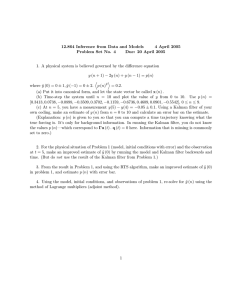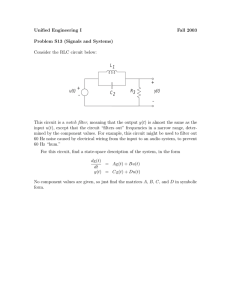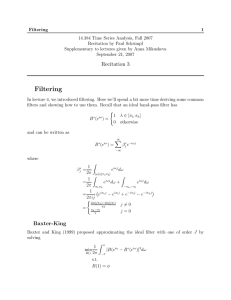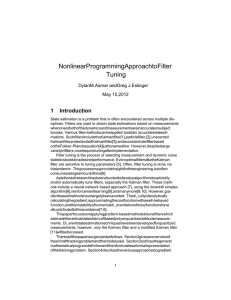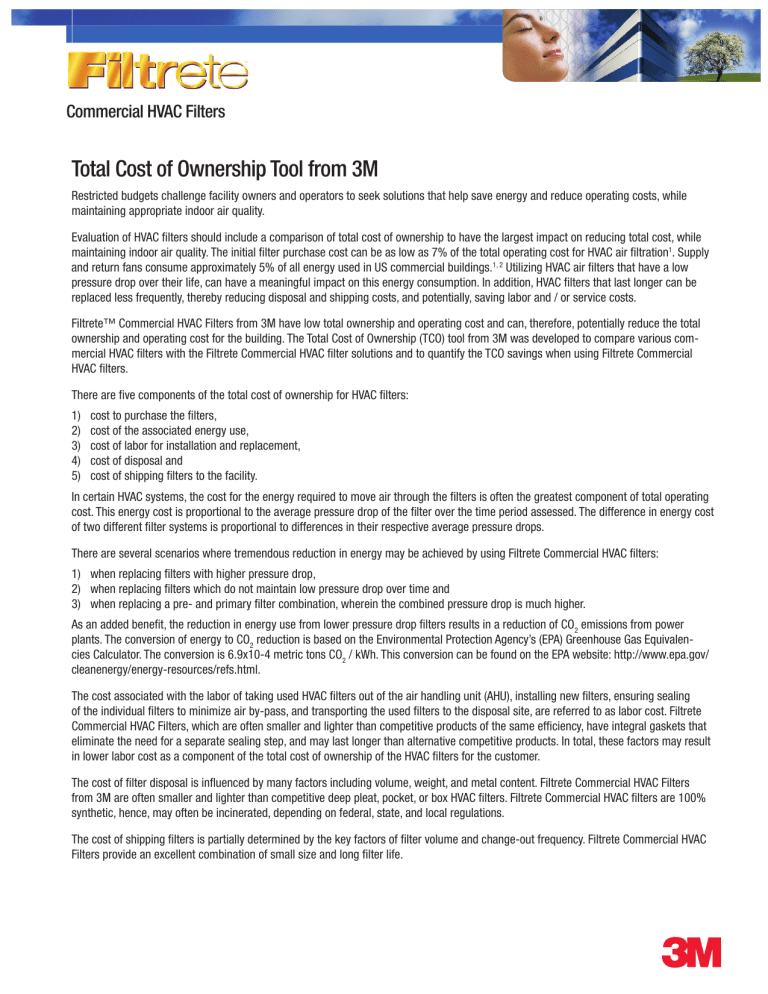
Commercial HVAC Filters
Total Cost of Ownership Tool from 3M
Restricted budgets challenge facility owners and operators to seek solutions that help save energy and reduce operating costs, while
maintaining appropriate indoor air quality.
Evaluation of HVAC filters should include a comparison of total cost of ownership to have the largest impact on reducing total cost, while
maintaining indoor air quality. The initial filter purchase cost can be as low as 7% of the total operating cost for HVAC air filtration1. Supply
and return fans consume approximately 5% of all energy used in US commercial buildings.1, 2 Utilizing HVAC air filters that have a low
pressure drop over their life, can have a meaningful impact on this energy consumption. In addition, HVAC filters that last longer can be
replaced less frequently, thereby reducing disposal and shipping costs, and potentially, saving labor and / or service costs.
Filtrete™ Commercial HVAC Filters from 3M have low total ownership and operating cost and can, therefore, potentially reduce the total
ownership and operating cost for the building. The Total Cost of Ownership (TCO) tool from 3M was developed to compare various commercial HVAC filters with the Filtrete Commercial HVAC filter solutions and to quantify the TCO savings when using Filtrete Commercial
HVAC filters.
There are five components of the total cost of ownership for HVAC filters:
1)
2)
3)
4)
5)
cost to purchase the filters,
cost of the associated energy use,
cost of labor for installation and replacement,
cost of disposal and
cost of shipping filters to the facility.
In certain HVAC systems, the cost for the energy required to move air through the filters is often the greatest component of total operating
cost. This energy cost is proportional to the average pressure drop of the filter over the time period assessed. The difference in energy cost
of two different filter systems is proportional to differences in their respective average pressure drops.
There are several scenarios where tremendous reduction in energy may be achieved by using Filtrete Commercial HVAC filters:
1) when replacing filters with higher pressure drop,
2) when replacing filters which do not maintain low pressure drop over time and
3) when replacing a pre- and primary filter combination, wherein the combined pressure drop is much higher.
As an added benefit, the reduction in energy use from lower pressure drop filters results in a reduction of CO2 emissions from power
plants. The conversion of energy to CO2 reduction is based on the Environmental Protection Agency’s (EPA) Greenhouse Gas Equivalencies Calculator. The conversion is 6.9x10-4 metric tons CO2 / kWh. This conversion can be found on the EPA website: http://www.epa.gov/
cleanenergy/energy-resources/refs.html.
The cost associated with the labor of taking used HVAC filters out of the air handling unit (AHU), installing new filters, ensuring sealing
of the individual filters to minimize air by-pass, and transporting the used filters to the disposal site, are referred to as labor cost. Filtrete
Commercial HVAC Filters, which are often smaller and lighter than competitive products of the same efficiency, have integral gaskets that
eliminate the need for a separate sealing step, and may last longer than alternative competitive products. In total, these factors may result
in lower labor cost as a component of the total cost of ownership of the HVAC filters for the customer.
The cost of filter disposal is influenced by many factors including volume, weight, and metal content. Filtrete Commercial HVAC Filters
from 3M are often smaller and lighter than competitive deep pleat, pocket, or box HVAC filters. Filtrete Commercial HVAC filters are 100%
synthetic, hence, may often be incinerated, depending on federal, state, and local regulations.
The cost of shipping filters is partially determined by the key factors of filter volume and change-out frequency. Filtrete Commercial HVAC
Filters provide an excellent combination of small size and long filter life.
The TCO tool from 3M analyzes each of the above components and projects costs over a defined assessment period, most often one year. The
tool is based on published engineering principles and guidelines, product performance, and significant customer input about the specific building
being analyzed. The tool contains two forms. The “Customer Information” form, that captures all required details of the facility, representative AHU
and filter attributes for competitive filters and the 3M solution. The “Summary of Results” form contains projected annual TCO savings per filter,
per AHU and for the entire building. Figure 1 and 2 show these two forms respectively.
Figure 1: Customer Information Page
Figure 2: Summary of Results Page
The TCO is modeled for a single representative AHU where the input airflow and pressure drop data is the average per filter slot. Utilizing the facility square footage, these results are then scaled to the entire facility. The costs are highly dependent on key input including: 1) filter characteristics, 2) filter change-out frequency, 3) annual average airflow rate per filter slot, 4) number of filters, and 5) utility and labor rates.
The projections calculated by the TCO tool from 3M are only as valid as the accuracy of the data entered. Data that has the biggest impact on
calculations, and at the same time, is of highest uncertainty, includes:
1) pressure drop of the filter when replaced,
2) the airflow used to calculate the TCO (must be the average for all filter slots for the building over the time period) and,
3) hours of operation for the air handling unit for the projection period.
TCO projections are only valid for fan drives that do not have fixed speeds. Examples of systems with variable fan speed are Variable Air Volume
systems or systems where the fan speed is adjusted through a Variable Speed Drive. The projection is NOT valid for Constant Fan Speed systems.
The validity of a projection for the entire building is based on equivalency of all AHUs.
Electronic copies of all completed TCO forms submitted to customers shall be provided to the 3M Purification Inc. Laboratory for review.
Example Total Cost of Ownership Prediction
The total cost of ownership (TCO) can vary significantly, depending on the changes in filter characteristics and AHU operating characteristics.
The following example will help illustrate this variation. Three filter options, A, B and C are described below and listed in Figure 3. The filter option
A is a pleated pre-filter in combination with a rigid box primary filter. The filter options B and C are both single mini-pleat filters with no pre-filter.
Option C is a filter with a pressure drop that increases at twice the rate as option B. These options are evaluated at four different scenarios and
are described below in Figure 4. The yearly difference in hours of operation is the difference between operating 12 hours for five days per week or
operating continuously. The two values for average flow per filter slot over the year is calculated. This difference in airflow would be the difference
in operating the typical 24 x 24 size filter at full or half capacity, where capacity is defined as airflow.
Option A
Option B
Option C
MERV 12
MERV 12
MERV 12
24 x 24 x 12
24 x 24 x 2
24 x 24 x 2
1
1
2
0.47
0.37
0.37
Efficiency
Pre-filter
Dimensions
MERV 8
24 x 24 x 2
Frequency of Change (per year)
4
Initial dp “w.c. (1970 CFM)
0.27
Est. change-out dp “w.c. (1970 CFM)
0.54
Hours per change-out per filter
0.2
Filter Cost
$5
Disposal Cost
$1
Efficiency
Primary filter
Dimensions
Frequency of Change (per year)
Initial dp “w.c. (1970 CFM)
Est. Change-out dp “w.c. (1970 CFM)
1.5
1.5
1.5
Hours per change-out per filter
0.4
0.4
0.4
Filter Cost
$60
$60
$60
Disposal Cost
$4
$1
$1
Figure 3: Variation of Filter Characteristics
Scenario
One
Two
Three
Four
Hours of Operation (annually)
3120
3120
8760
8760
Average filter slot airflow (CFM)
1000
2000
1000
2000
Site Electric Costs $ / kWh
$0.15
$0.15
$0.15
$0.15
Labor Rate $/ hour
$50
$50
$50
$50
Figure 4: Variation of AHU Operation Conditions
Figure 5 shows that the variation in the TCO
per filter can vary significantly with change
in hours of use and flow rate. When systems
run continuously at high airflow, energy is the
driving factor in ownership cost. When systems run a fraction of the year at low airflow,
energy becomes less important.
Total Cost Of Ownership Projections Per Filter
$800
$700
$600
$500
Filter Option A
Basis and Calculations of the Total
Cost of Ownership Tool from 3M
$400
Filter Option B
$300
Filter Option C
The following is a review of the tool, calculation procedures and the assumptions used.
$200
$100
$0
The National Air Filtration Association (NAFA)
Scenerio 1
Scenerio 2
Scenerio 3
Scenerio 4
has developed a Life Cycle Cost Analysis
(LCCA-2007) tool for calculation of Total
Cost of Ownership.3 Where appropriate, the
Figure 5: Variation in TCO based on different filters and AHU operation
improvements in the TCO tool from 3M are
compared and contrasted to those in the NAFA
calculations.
Power and Energy
The power utilized by a fan motor is related to the pressure drop of system components, with the HVAC filter being one of those components.
The power utilized by the fan motor for moving air through a filter is a function of airflow and pressure drop. The integration of power over time
provides the energy utilized by the fan. The equations for fan power and energy cost are given in Equation 1 and Equation 2, respectively.3, 4
Equation 1:
Q x ΔP
Fan Power
=
ηfan_system
x
(
1
8510
)
Equation 2:
Cost = FanPower x time (hr) x ElecCost ($ / kWH)
Where FanPower
=
Power utilized by the fan motor
Q
=
airflow (CFM)
ΔP
=
avg. pressure drop (inches w.c.)
Δfan_system =
fan system efficiency
t
time (hr)
=
Airflow
The average airflow through an HVAC filter is dependent on the specific AHU, the AHU control type, minimum ventilation requirements, and the
nature of the heating and cooling loads. The largest determinant of HVAC design velocity is the cooling coil size. Cooling coils provide dehumidification. A limit of 600 FPM is recommended to prevent water carry-over.5 Because typical coil area is roughly equal to filter area, the velocity of the
coil is also typical for filter face velocity.
In Constant Speed and Constant Volume configurations, the AHU has a relatively fixed airflow. This airflow is dependent on the design and installation of the HVAC equipment. For comfort applications, typical coil face velocity is in the range of 400-500 FPM.5
For Variable Air Volume configurations, the airflow is also dependent on whether an economizer mode of operation is in use. When economizer
control is utilized, the airflow is generally higher. This increase is the result of outside air having a higher enthalpy than mechanically cooled air.6
Due to the cyclical nature of cooling loads, the airflow will vary depending on time of day and day of the season. Airflow is increased during the
day and in the summer, and decreased at night and in the winter. This is particularly true if the heat source is heat gain from exterior surfaces.
Estimating the average airflow in the case of VAV control requires continuous in-situ monitoring over significant time periods. This average airflow
rate is very specific to the building. Therefore, a reasonable TCO prediction requires accurate customer input based on building information management system data.
Based on the above description, in the absence of specific facility data, a default value of 400 FPM is utilized in the TCO tool from 3M.
Filter Pressure Drop
Filter pressure drop is dependent on airflow across the filters, denoted dp. Filter dp is typically measured in inches of water column, denoted
“w.c.” To estimate the energy use related to the filter for a period of time, the average in-use filter pressure drop over the period of time being
assessed must be estimated, or continuously measured, then averaged.
A simplified estimate of the average pressure drop is to utilize the average of the initial and final pressure drop of the filter. This is the method
utilized by the NAFA LCCA tool and is shown in Equation 3, where the final dp is the final recommended pressure drop. The filter loading rate is
based on an estimate of the replacement interval.
Equation 3:
dpavg = (initial dp + final dp ) / 2
A more detailed estimate is utilized in the TCO tool from 3M. The three improvements in this estimate include:
1) a method to account for the dependency of filter pressure drop with airflow,
2) a method to account for the fact that the filter pressure drop at change out is generally not the recommended final dp and is dependent on
filter change out frequency, and
3) a method to determine the average pressure drop that takes into account the typical exponential pressure drop rise as the filter loads.
Estimating filter pressure drop dependency with airflow
Filter pressure drop varies with airflow. 3M has developed a mathematical equation for calculating filter dp as a function of airflow. This equation
was developed by measuring and analyzing numerous HVAC filter types, both from 3M and from competitors. This equation has also been shown
to be reasonable for loaded HVAC filters and is shown in Equation 4.
Equation 4:
dp2 = dp1 (Q2 / Q1)1.26
Where
Q1
= airflow at measured pressure drop at state 1
dp1
= measured differential pressure at state 1
Q2
= specified airflow
dp2
= projected pressure drop at specified airflow
Published data for pressure drop of new HVAC filters at the rated airflow is used for values in state 1. Likewise, when the pressure drop of the
loaded filter is either estimated or measured, the values to establish the dependency of pressure drop with airflow for the loaded filter can be
substituted in state 1.
An example use of the Equation 4 is shown in Figure 6. This figure shows data taken from an actual ASHRAE 52.2 test report for the FiltreteTM
Commercial HVAC Filter MERV A13 Mini-Pleat with Gasket. The filter pressure drop was taken over a series of flow rates at initial and after four
different loaded amounts. The actual measured data is shown as points on the graph. The projected values from Equation 4, based on the 2000
CFM data, are shown as a line series. The predicted values closely match the actual data for both the initial case and during filter loading.
Pressure Drop ("w.c.)
A13 Dust Fed Curves
2 .5
2 .4
2 .3
2 .2
2 .1
2.0
1.9
1.8
1.7
1.6
1.5
1.4
1.3
1.2
1.1
1.0
0 .9
0 .8
0 .7
0 .6
0 .5
0 .4
0 .3
0 .2
0 .1
0
Init ial
A f t er 1/ 4 d P r ang e
A f t er 1/ 2 d P r ang e
A f t er 3 / 4 d P r ang e
A f t er E nd d P r ang e
Int
1/ 4 Pr o ject ed
1/ 2 Pr o ject ed
3 / 4 Pr o ject ed
E nd Pr o ject ed
0
50 0
10 0 0
150 0
2000
2 50 0
3000
3 50 0
Air Flow Rate (CFM)
Figure 6: Example of Equation 4 Applied to An Actual Filter
Estimating Filter Pressure Drop At Change Out
To estimate the average filter pressure drop it is necessary to know or have a reasonable estimate of the pressure drop at change-out. The TCO
tool from 3M utilizes the following estimates for the change-out pressure drop of the pre and primary filters, based on experience working with
many building operators over numerous years. These estimates are based on change-out pressure drop at the rated filter airflow, which is generally 1970 CFM for a 24” x 24” filter, based on the ASHRAE 52.2-2007 standard.
1) Pre-filter: the change-out pressure drop is twice the initial pressure drop.
2) Primary filter: the change-out pressure drop is the lower of either three times the initial pressure drop or 1.5 “W.C.
Estimating Average dp
Utilizing the simplified NAFA estimate of average shown in Equation 3 does not account for the shape of the loading rate curve, and, therefore,
reduces the importance of initial pressure drop. The TCO tool from 3M utilizes Equation 5 to better reflect the shape of filter loading curves.
Equation 5:
dpAvg
where
=
dp1
x
dpco - dp1
3
dp1
=
initial pressure drop
dpCO
=
change out pressure drop
Fan System Efficiency
The electricity required to operate a HVAC fan system is not perfectly converted to useful power (airflow rate x total pressure). Energy is lost in the
fan, electric motor, fan motor belt, and adjustable speed drive. In addition, the specific HVAC system design reduces the fan performance. All these
factors combined, cause an increase in the required electric power above the useful power of the fan.
The fan system efficiency is a fraction which accounts for the difference in output power to input electrical power and is defined in Equation 6.
Equation 6:
ηfan_system = ηfan * ηmotor* ηbelt* ηASD* PF
Where
ηfan
=
fan efficiency
ηmotor
=
motor efficiency
ηbelt
=
belt efficiency
ηASD
=
adjustable speed drive efficiency
PF
=
Power Factor
The default values utilized in the TCO tool from 3M are listed below.
ηfan
=
85%
ηmotor
=
90%
ηbelt
=
98%
ηASD
=
95%
PF
=
0.9
These values are conservative and result in a system efficiency of 65%.
Efficiency Varies With Operating Condition
At a minimum the fan, electric motor and adjustable speed drive (ASD) efficiency vary with time. The fan peak, or optimal, efficiency only occurs
at a specific fan operating point and decreases with either increasing or decreasing airflow rate.7 The electric motor efficiency is highest at higher
torque and lower at partial load.8 The efficiency of variable frequency drives, a type of ASD, will vary as the output frequency varies. An example of
how efficiency of the drive system varies follows based on an ASHRAE research project.9
“Furthermore, the efficiency of the motor and adjustable speed drive (ASD) will vary with speed and torque. In an
ASHRAE-sponsored research project, values of 82% for an ASD-motor system were measured at full load. However, at 50% speed this efficiency declined to an average of 68% for mid-range torque levels”.
Fan And Motor Efficiency
The highest efficiency type centrifugal fans are backward-inclined and airfoil. Generally, the optimum of these types of fans can approach
90%.10,11 Large induction motor efficiency can be as high as 95% at full load, though 90% is more common.8
Power Factor
Because motors are inductive, they distort the ac phase angles of voltage and current. This effect causes some power to dissipate across the
electric circuit. Power factors of small motors can be as low as 50%. The power factor in large fully loaded high speed motors can be as favorable
as 90% for large high speed motors.8
Order of Calculation
The following sequence of steps are used in the TCO tool from 3M.
1.
2.
3.
4.
5.
Estimate primary filter pressure drop at the standard 1970 CFM airflow.
Estimate average pressure drop at the standard 1970 CFM (Equation 5).
Adjust dpAvg for actual average airflow from the standard 1970 CFM (Equation 4).
Add both pre-filter and primary filter pressure drop.
Calculate energy use based on total average pressure drop and average airflow.
Scaling TCO AHU to Building
Once an estimate of a representative AHU has been made, these costs are normalized to cost per filter. Based on the square footage of the building, an estimate is made to how many filter slots the building contains. This estimate is one 24” x 24” size filter for 2000 square feet. The basis of
this calculation is to assume an average fresh air requirement of 0.1 CFM per square foot and assume 10% outside air for a total of 1 CFM of air
per square foot. Utilizing the typical capacity of a 24” x 24” filter, 2000 CFM, results in the conversion factor of 2000 square feet per filter. If more
detailed data on the number of actual filter slots is known, the actual number of slots may be used. The cost per filter is then multiplied by this
estimated or known number of filter slots for the building.
Summary:
There are five components of the ownership and operating cost of HVAC filters: the cost to purchase the filters, the cost of the associated energy
use, the cost of labor for installation and replacement, the cost of disposal, and the cost of shipping. Using Filtrete™ Commercial HVAC Filters
may have a positive impact on the ownership and operating cost as a result of their low pressure drop and their design for long filter life. The Total
Cost of Ownership tool from 3M, for HVAC Commercial air filtration systems, can be utilized to compare Filtrete Commercial HVAC Filters with
alternative filter options and to predict the TCO savings when using Filtrete Commercial HVAC Filters.
Bibliography
1. Arnold, D., “Life-Cycle Costing Of Air Filtration.” ASHRAE Journal, Vol 47, No. 11, 2005.
2. National Air Filtration Association. NAFA Guide to Air Filtration. 4th ed. Virginia Beach, VA: NAFA 2007.
3. The Trane Company. Trane Air Conditioning Manual. 73rd Printing. La Crosse, Wisconsin: The Trane Company 2002.
4. ASHRAE. 2004 ASHRAE Handbook: HVAC Systems and Equipment. Atlanta, GA: ASHRAE, 2004.
5. Yao, Y., and L. Wang, “Energy analysis on VAV system with different air-side economizers in China.” Energy and Buildings 42, (8): 1220-1230,
2010.
6. AMCA International Fan Industry – Facing up to the Energy Challenges, AMCA International, 2007 (http://www.amca.org/publications/whitepaper/feg.aspx).
7. Kuphaldt, T., Lessons Learned In Electric Circuits, Volume II – AC. 6th ed. 2007 (http://www.allaboutcircuits.com/vol_2/chpt_13/7.html).
8. Kavanaugh, S., “Fan Demand and Energy” ASHRAE Journal June 2000.
9. American Conference of Governmental Industrial Hygienists. Industrial Ventilation: A Manual of Recommended Practices. 22nd ed. Cincinnati,
Ohio: American Conference of Governmental Industrial Hygienists, 1995.
10. Lindeburg, M., Mechanical Engineering Reference Manual for the PE Exam. 11th ed. Belmont, California: Professional Publication, 2001.
11. Rishel, J., “Wire-to-Shaft Efficiency” ASHRAE Journal July 2010.
12. Brodrick, J.R., Westphalen, D., “Uncovering Auxiliary Energy Use”, ASHRAE Journal Vol. 43.3, pg. 58-61, 2001.
IMPORTANT NOTICE: The information in this literature is based on tests 3M Purification Inc. believes are reliable. It is not and should not be relied on as a product or technical
specification. We do not guarantee the accuracy of this information. You are responsible for determining whether products described in this literature are fit for a particular
purpose and suitable for your application. Because there are many factors within your knowledge and control that might affect the use and performance of these products, you
must evaluate these products to determine whether they are fit for a particular purpose, are suitable for your application, and meet your performance expectations. 3M PURIFICATION INC. IS NOT LIABLE FOR ANY LOSS OR DAMAGES, WHETHER DIRECT, INDIRECT, SPECIAL, INCIDENTAL, OR CONSEQUENTIAL ARISING OUT OF THE USE OF OR INABILITY
TO USE ANY OF THESE PRODUCTS.
IMPORTANT USE RESTRICTIONS: DO NOT EXPOSE THIS FILTER DIRECTLY TO UV RADIATION FROM A UV PURIFICATION SYSTEM. EXCESSIVE UV EXPOSURE MAY LEAD TO A
REDUCTION IN THE MECHANICAL INTEGRITY AND PERFORMANCE OF THE FILTER. THIS FILTER MUST NOT BE USED FOR THE FOLLOWING UNAUTHORIZED USES: A) ASBESTOS,
LEAD OR MOLD REMEDIATION; B) BIOTERRORISM PROTECTION; C) APPLICATIONS IN BUILDING THAT REQUIRE OR ARE UNDERGOING AIR HANDLING SYSTEM REMEDIATION OF
HAZARDOUS SUBSTANCES; OR D) PROTECTIVE ENVIRONMENTS PER AIA GUIDELINES.
Your Local Distributor:
3M Purification Inc.
400 Research Parkway
Meriden, CT 06450
U.S.A.
(800) 648-3550
(651) 789-7381
www.filtrete.com/commercialbuilding
3M and Filtrete are trademarks of 3M Company.
© 2011 3M Company. All rights reserved.
Please recycle. Printed in U.S.A.
70-0202-7562-7
REV 0511



